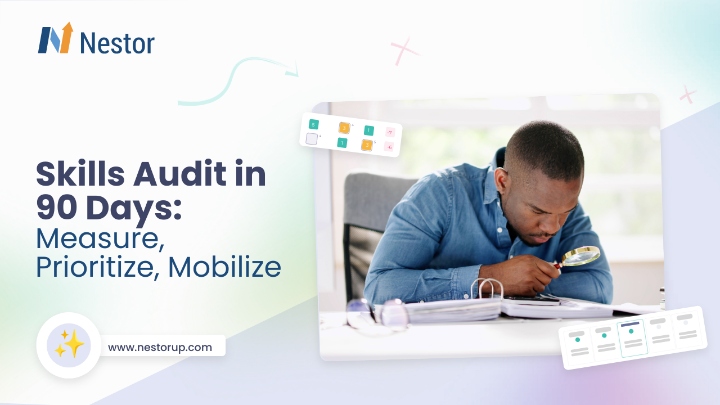
Contents
We’ve all heard the term “soft skills” thrown around in HR meetings, on social media, or even in conversations within the HR industry. But let’s face it—there’s nothing soft about the skills that truly drive success. In the past few years, these skills have evolved into something more complex, combining the human factor with technical expertise to form something new: power skills.
Power skills are the perfect fusion of traditional soft skills and hard technical abilities, creating a potent blend essential in today’s work landscape. These skills make employees more versatile, adaptable, and effective problem-solvers. Individuals with power skills not only have the technical expertise to excel at their tasks but also the emotional intelligence to navigate challenging interpersonal situations, the creative flair to solve problems in innovative ways, and the agility to embrace change as if it were second nature.
But why should you care? Well, unless you’re planning on being replaced by AI (and let’s be honest, who isn’t a little worried about that?), power skills might just be your ticket to long-term organizational growth.
According to PMI “Pulse of the Profession” 2023 survey, 92% of the survey respondents believe that power skills are absolutely essential in the workplace – regardless of region, industry, or years of experience. This idea is backed up by the Future of Job Skills 2023 report, which shows that today’s organizations increasingly expect their employees to bring core skills like analytical thinking, creativity, flexibility, motivation, self-awareness, curiosity, a love for lifelong learning, and a strong sense of ethics to the table.
In this article, we’ll take a closer look at how power skills have evolved into the must-have tools for success. We’ll explore why these skills are in such high demand around the world and highlight the key ones that are shaping the future of work. Plus, we’ll share some practical tips on how both organizations and individuals can develop and make the most of these game-changing abilities.
Are you ready to tap into your full potential and boost your organization’s performance Or are you content to be left behind, clinging to outdated notions of what makes a valuable employee? The choice is yours, but fair warning: by the end of this article, you might just find yourself itching to embrace the power skills revolution.
The Evolution of Power Skills: From Nice-to-Have to Must-Have
Once upon a time, soft skills were considered the “nice-to-have” extras in a job description, the qualities that made you pleasant to work with but weren’t always detrimental to your role. They included traits like communication, teamwork, and a bit of emotional intelligence—skills that were frequently pushed aside in favor of technical expertise. So, what sparked this metamorphosis?
Of course, this shift didn’t happen overnight. It’s been driven by the significant changes in how we work. With the rise of digital technology and remote work, the nature of collaboration and communication has transformed. As repetitive tasks are increasingly automated, what remains essential is not just knowing how to perform a job but knowing how to do it effectively.
Take communication, for instance. In the past, it might have been enough to write a clear email or give a decent presentation. Now, effective communication requires a wide range of skills: crafting compelling narratives, navigating cross-cultural interactions, interpreting nonverbal cues in video calls, and even understanding the nuances of different digital platforms. It’s no longer just about what you say, but how you say it, where you say it, and to whom you’re saying it.
The massive shift to digital and hybrid work models has accelerated this transformation even further. Abruptly, competencies that were negligible in a conventional job setting have become indispensable for a good performance. These days, it’s imperative to have the skills needed to promote teamwork in a remote setting, stay motivated without the structure of a physical office, and manage all the aspects of a digital collaboration.
This evolution has not gone unnoticed by the business world. According to LinkedIn’s 2023 report, between 2022 and 2023, more than 45% of hirers explicitly used skills data to fill their roles, marking a 12% increase year over year. Even more tellingly, roughly one in five job postings (19%) in the US no longer requires degrees, up from 15% in 2021. This shift toward skills-based hiring clearly indicates the growing importance of power skills in the eyes of employers.
Power Skills vs. Soft Skills
To truly understand the significance of power skills, it’s important to first examine how they differ from the traditional concept of “soft skills.” While soft skills have been recognized for years as an essential part for professional fulfillment, the power skills concept takes a broader and strategic approach to job-related abilities.
Historically, soft skills were seen as the “nice-to-have” qualities that complemented technical expertise. The emphasis on soft skills reflected an era where roles were more rigidly defined, and jobs were largely carried out in traditional office settings. The soft skills in demand were those that facilitated interpersonal interactions and helped maintain a harmonious work environment.
Employers appreciated employees who were pleasant to work with, could navigate office politics, and managed to get along with colleagues. Yet, despite their importance, soft skills were often not as highly prioritized as measurable technical competencies. In contrast, power skills go beyond the surface-level interpersonal abilities and incorporate a more balanced blend of hard and soft skills.
But what makes power skills so, well, powerful? The key lies in their versatility and applicability across various contexts. While soft skills are often situational – for example, conflict resolution skills might only come into play during disagreements – power skills are foundational capabilities that inform every aspect of an employee’s performance.
Take critical thinking, for instance. This power skill isn’t just about solving complex problems; it’s about approaching every task, interaction, and decision with a thoughtful, analytical mindset. An employee with strong critical thinking skills will not only excel at their technical tasks but will also be better equipped to navigate office politics, contribute to strategic discussions, and adapt to changing business conditions.
It’s worth noting that the rise of power skills doesn’t negate the value of traditional soft skills. Rather, it builds upon and expands them, creating a more comprehensive and nuanced understanding of workplace competencies. Communication skills, for instance, are still crucial – but in the power skills paradigm, they’re viewed as part of a broader set of capabilities that include digital communication, cross-cultural fluency, and the ability to translate complex ideas across different domains.
Key Power Skills for the Modern Workforce
Okay, so we’ve established that power skills are the new black but for a better understanding we also need to see some examples. These skills can be broadly categorized into three interconnected domains: communication and teamwork, leadership and management, and productivity and collaboration.
Communication and Teamwork
In the digital age, where remote work has become the norm and global teams are the standard, the ability to communicate effectively and collaborate seamlessly has taken on a whole new level of importance.
Business writing is a very good example in this case. In an age where a single poorly worded email can damage relationships and collaborations, or even go viral, the ability to communicate clearly and effectively in writing is more important than ever. This isn’t just about grammar and punctuation (though those certainly matter). It’s about understanding your audience, crafting compelling narratives, and conveying complex ideas in accessible ways. Whether you’re writing a project proposal, a client report, or even a simple team update, your writing skills can significantly impact how your ideas are received and acted upon.
Equally important is emotional intelligence – perhaps one of the most critical power skills in today’s workplace. The ability to recognize, understand, and manage your own emotions, as well as those of others, can have a profound impact on team dynamics, conflict resolution, and overall workplace harmony. Leaders with high emotional intelligence are better equipped to motivate their teams, navigate difficult conversations, and foster a positive work environment.
Other examples include digital proficiency, persuasion and negotiation, intercultural fluency and the examples could go on. These power skills don’t exist in isolation – they interact and reinforce each other. An individual who can combine emotional intelligence with intercultural fluency, for instance, is well-equipped to lead global teams. Similarly, someone who pairs digital proficiency with adaptive thinking can drive digital transformation in ways that others might not even consider.
Leadership and Management
The leaders who thrive are those who can navigate uncertainty, inspire innovation, and guide their teams through constant change. Critical thinking sits at the heart of effective leadership. In a world awash with information (and misinformation), leaders must be able to analyze data, question assumptions, and make sound decisions based on evidence rather than gut feeling or tradition.
Problem-solving goes hand in hand with critical thinking. Leaders today need to be adept at breaking down complex issues, identifying root causes, and developing innovative solutions. This often involves thinking outside the box and being willing to challenge the status quo. A leader who can guide their team through a thorough problem-solving process, rather than jumping to quick fixes, is worth their weight in gold.
Strategic thinking is another crucial leadership skill. Leaders need to be able to see the big picture, anticipate future trends and challenges, and align their team’s efforts with long-term organizational goals. This involves not just planning for the future, but also being able to communicate that vision in a way that inspires and motivates others.
And of course, in our increasingly diverse and inclusive workplaces, leaders also need strong skills in diversity and inclusion. Leaders need the skills to build and manage diverse teams, create inclusive environments where all voices are heard, and leverage diversity as a source of strength and innovation. This involves developing cultural intelligence, recognizing and mitigating unconscious biases, and fostering a culture of belonging.
Productivity and Collaboration
In our hyper-connected, where remote and hybrid work models are becoming the norm, power skills focused on productivity and collaboration have become indispensable. The traditional 9-to-5, everyone-in-the-same-office model is rapidly becoming a relic of the past. Today’s professionals need to be able to work effectively across time zones, cultures, and digital platforms.
Time management has always been important, but it’s taken on new dimensions in the age of remote work and constant digital distractions. It’s not just about managing your own time anymore – it’s about respecting others’ time, setting clear boundaries between work and personal life, and being able to prioritize effectively in a world of competing demands and endless notifications. In a world where the lines between work and personal life are increasingly blurred, the ability to manage time effectively can be the difference between thriving and burning out.
Digital literacy has moved from being a specialized skill to a fundamental requirement for nearly every job. Microsoft Office is just not enough anymore. Today’s professionals need to be proficient with a wide range of digital tools for communication, project management, data analysis, and collaboration. They need to be able to troubleshoot basic tech issues, understand digital security best practices, and quickly adapt to new tools as they emerge.
Collaboration in the modern workplace is not just about in-person offices, it’s also about virtual environments. It involves knowing how to contribute effectively to team projects, how to give and receive feedback constructively, and how to navigate the complexities of cross-functional and often globally distributed teams. Skilled collaborators can bridge gaps between different departments or locations, fostering a sense of unity and shared purpose even in dispersed teams.
But here’s the thing – investing in the latest collaboration tools won’t help you if your organization hasn’t cultivated a culture of effective communication and timely execution. After all, what’s the value of groundbreaking ideas if they can’t be efficiently shared and implemented across teams? But it’s not all doom and gloom. The beauty of these power skills is that they can be learned and improved over time. Not everyone is a natural-born leader and that’s okay! The key is to recognize the importance of these skills and commit to developing them.
Strategies for Building Power Skills
Now that we’ve explored the importance of power skills and identified some key competencies, you might be wondering “How can my organization foster these abilities in our workforce?” Fear not – developing power skills is a journey, and there are numerous strategies you can employ to build and enhance these abilities.
Embrace a Culture of Continuous Learning
For organizations serious about developing power skills in their workforce, a comprehensive, strategic approach is key. One effective strategy is to implement targeted learning and development programs. These programs should be designed to address specific power skills that are particularly relevant to your organization’s needs and goals. For instance, if your company is expanding into new international markets, you might focus on programs that enhance intercultural communication skills. If you’re navigating a major digital transformation, programs that boost adaptability and digital literacy might be prioritized.
But here’s the catch – these programs need to be more than just theoretical. They should incorporate practical, hands-on learning experiences that allow employees to apply their new skills in real-world scenarios. This could involve simulations, role-playing exercises, or even temporary job rotations that push employees out of their comfort zones and into situations where they need to use their power skills.
Another powerful strategy is to incorporate power skills development into your performance management processes. By explicitly including power skills in performance evaluations and goal-setting discussions, you send a clear message about their importance. This approach also provides a framework for ongoing feedback and development in these crucial areas. Mentoring and coaching programs can also be incredibly effective for developing power skills. Pairing less experienced employees with seasoned mentors who excel in specific power skills can provide valuable learning opportunities and real-world insights. These relationships can help employees see how power skills are applied in practice and provide a safe space for them to practice and receive feedback.
Leverage Technology for Skill Development
In our digital age, technology offers powerful tools for skill development that can significantly enhance the learning experience and make it more accessible and effective. These advancements are transforming how we approach training and professional growth, allowing for more tailored and flexible learning opportunities.
First, let’s discuss the power of microlearning platforms. For businesses, offering long, traditional training sessions can be disruptive and time-consuming, often pulling employees away from their daily tasks. Microlearning offers a smarter solution. These platforms break training into short, focused modules that can be completed in just a few minutes, allowing employees to fit development into their busy schedules. Whether they’re waiting for a meeting or have a short break between tasks, they can easily engage in meaningful learning without sacrificing productivity.
For organizations that want to prepare employees for high-stakes situations, such as public speaking, conflict resolution, or crisis management, Virtual Reality (VR) training is an ideal tool. It allows employees to step into simulated scenarios that feel incredibly real, enabling them to practice responses, experiment with different approaches, and gain confidence. For example, an employee can practice delivering a presentation to a virtual audience or handling a difficult customer interaction, all without the pressure of a real-world setting. This hands-on approach accelerates skill development, as employees learn through experience rather than theory.
Artificial Intelligence (AI) is making learning more personalized than ever. For organizations, one-size-fits-all training programs can often miss the mark, failing to address individual employees’ specific needs or career goals. That’s where AI comes in. AI-powered systems analyze each employee’s role, skills, and development areas to create tailored learning paths. This ensures that employees receive targeted training that directly aligns with their job requirements and personal growth plans. Whether it’s recommending courses that close skill gaps or providing continuous feedback to improve performance, AI-driven learning adapts to the learner.
Prioritize Emotional Intelligence and Soft Skills Training
It’s easy to get caught up in the technical aspects of the job, especially in industries where expertise in specific tools, systems, or processes seems to drive performance. But the reality is that no matter how skilled your team is technically, the “human” side of work—the ability to connect, communicate, and collaborate effectively—is often the difference between a team that merely functions and one that excels.
Most people don’t naturally excel at things like navigating workplace emotions, delivering difficult feedback, or resolving conflicts. These are not skills you learn once and master forever; they take time, effort, and continuous improvement. Yet, they are the skills that enable teams to collaborate smoothly, leaders to inspire and support their people, and employees to thrive in a dynamic work environment. So, how can organizations help their employees build these abilities? It starts with a commitment to integrating soft skills training into the core of your employee development programs.
Emotional intelligence (EI) is often overlooked when we talk about success in the workplace, but it’s important for maintaining a positive, productive culture. Emotional intelligence isn’t just about being “nice” or empathetic; it’s about being aware of your own emotions and understanding how they affect others. Offering workshops focused on emotional intelligence can lead to a more self-aware and resilient workforce. These sessions should cover the basics of self-awareness, which involves recognizing one’s emotions and understanding how they influence behavior. From there, employees can dive into empathy—one of the core components of EI—which allows them to better understand and relate to their colleagues, fostering a more inclusive and supportive workplace.
Clear, concise, and effective communication is essential to getting work done, but it’s also vital for maintaining a healthy culture and strong relationships within teams. Yet, poor communication continues to be one of the biggest pain points in most workplaces. Workshops that focus on communication can cover a wide range of topics, from the basics of writing clear emails and reports to mastering verbal communication in both one-on-one and group settings.
Through conflict resolution seminars, you can equip your team with practical tools to address issues head-on, engage in open dialogue, and find solutions that work for everyone involved. These seminars can teach employees how to approach conflicts with a problem-solving mindset rather than a confrontational one. They’ll learn techniques for de-escalating tense situations, understanding the root causes of disagreements, and facilitating conversations that lead to positive outcomes.
Create a Feedback-Rich Environment
Building a feedback-rich culture in your organization is one of the most effective ways to develop power skills across your workforce. Power skills, by their nature, require continuous growth and refinement, and feedback is the fuel that powers this development. Yet, too many businesses still rely on outdated methods of evaluation, like annual performance reviews, which are often too formal, infrequent, and disconnected from the day-to-day reality of an employee’s work.
First and foremost, regular check-ins are a game changer. Implementing more frequent, informal feedback sessions can create a culture of real-time improvement. It doesn’t have to be a burdensome task for managers either. Even a quick five-minute conversation can make a huge difference. When feedback is given in smaller, more regular doses, employees are able to act on it immediately, turning it into practical, ongoing skill development.
Beyond those one-on-one conversations, 360-degree feedback systems are an incredibly valuable tool for fostering power skills. Many organizations focus only on top-down feedback, where managers tell employees what they need to improve. While important, this ignores the rich insights that can come from peers and even subordinates. A 360-degree system provides a more overall view of an employee’s strengths and areas for growth. For example, someone may receive glowing reviews from their manager for meeting project deadlines, but peers might highlight areas where they could improve teamwork or communication.
And it’s not just about external feedback. Self-reflection is a powerful tool that many organizations underestimate. Encouraging employees to regularly assess their own performance can have a profound impact on their personal and professional growth. Self-reflection exercises—like guided journaling or self-evaluation forms—are a fantastic way to get employees to take ownership of their development. These exercises prompt individuals to think critically about their achievements, identify areas where they’ve grown, and acknowledge where they could use more focus.
Measure and Iterate
Just like any other strategic initiative, developing power skills isn’t a one-off event. It’s a continuous process that requires attention, evaluation, and the flexibility to adapt as you go. Think of it like nurturing a garden: you need to plant the seeds, tend to them, monitor their growth, and occasionally change tactics when something’s not thriving. The same goes for building power skills within your organization.
First things first, you need to set the right metrics. It’s easy to get caught up in the excitement of launching a new training program or introducing workshops, but without clear KPIs (Key Performance Indicators), how do you know if it’s making a real impact? Power skills, by their nature, can be a bit tricky to quantify. It’s not as straightforward as measuring how many units were produced or how much revenue was generated. But that doesn’t mean you can’t create meaningful key performance indicators (KPIs) to track progress.
For example, are you hoping to see an improvement in employee engagement? You might track things like job satisfaction scores, collaboration rates, or team feedback. Or, if you’re focusing on innovation, you could look at how often employees are contributing fresh ideas or leading new projects.
But don’t stop there. Communicate these goals clearly with your employees. People need to understand what’s being measured and why. When employees see that their own development is being tracked, and that the company genuinely cares about their growth, it builds a stronger commitment to the initiative.
Once you’ve set your metrics, don’t let them gather dust. Regular reviews are essential for keeping your program on track and ensuring that it evolves with the needs of your workforce. Conduct periodic check-ins, not just to assess the hard data, but also to gather feedback from your employees. How do they feel about the development opportunities you’re providing? What’s working well for them, and where do they feel improvement is needed?
Sometimes, despite the best intentions, things might not go as planned. Maybe the power skills training you launched isn’t resonating with employees the way you thought it would. Or maybe the new collaboration tool you introduced to improve teamwork hasn’t quite caught on. It’s important to have honest conversations about what’s working and what’s not. That means asking employees for input, both informally and through structured channels like surveys or focus groups.
Finally, understand that the process of building power skills is ongoing. As your industry changes, so too will the skills your employees need to succeed. Encourage a culture of continuous learning where skill development is seen as part of the everyday work experience, rather than a one-time event. By regularly measuring, iterating, and fine-tuning your approach, you ensure that your organization is always moving forward.
Final Thoughts
Power skills have shifted from being a nice-to-have bonus to an absolute necessity. They represent the human abilities that machines can’t replicate—creativity, emotional intelligence, adaptability, and leadership. In a time when technical skills alone are no longer enough, these power skills enable individuals and organizations to thrive amidst change and uncertainty.
In the end, power skills are what make the difference between simply getting by and truly excelling. So, whether you’re an organization or an individual, investing in these skills is a smart move for long-term success and staying ready for whatever the future holds.










